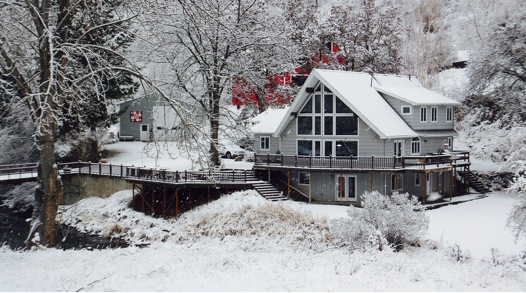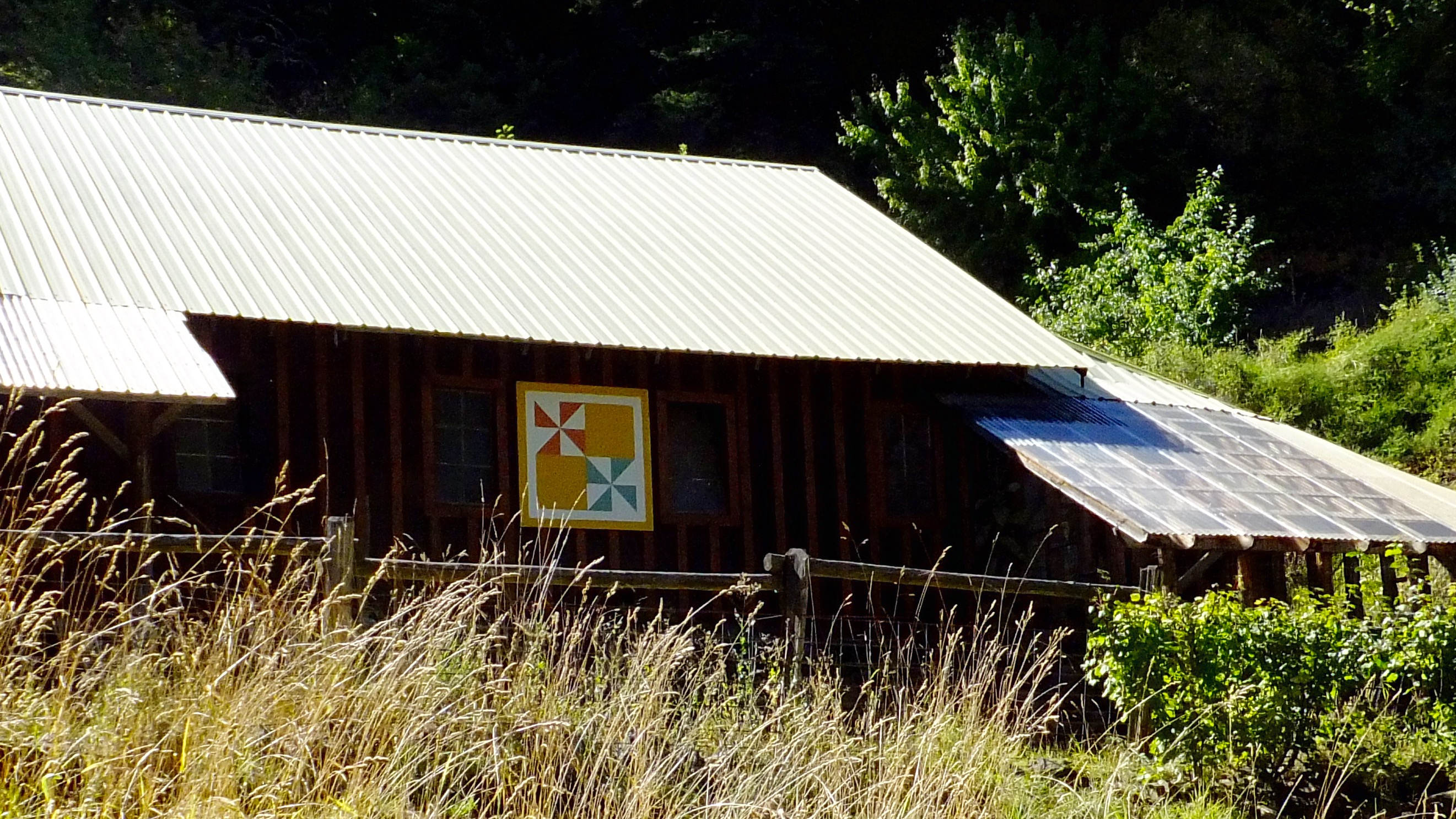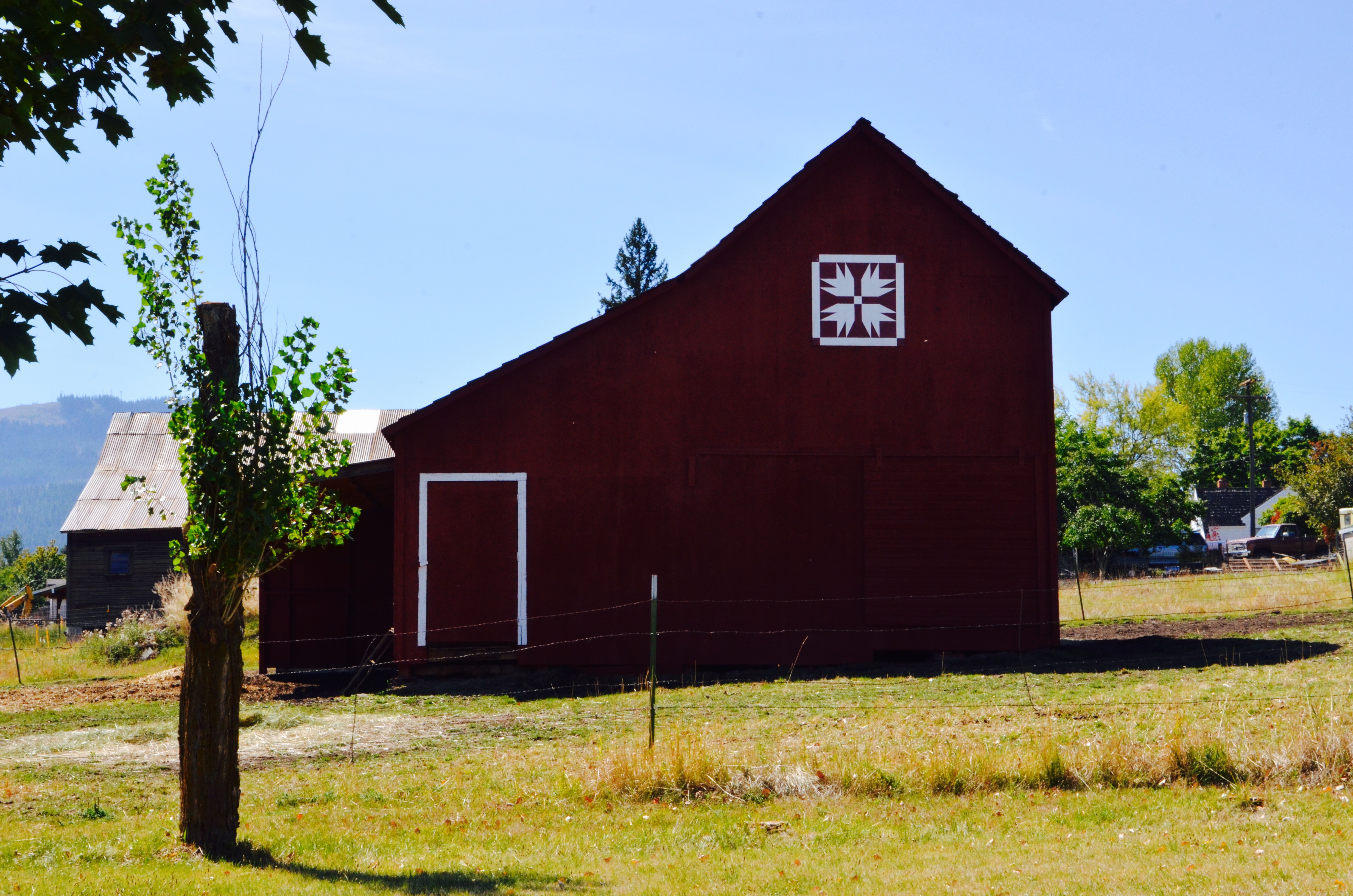
|
Author’s home in Idaho; “Orion Star” quilt block in
red-and-white
pattern visible on out-building beyond main house
|
In late summer of 2012, the huge Sheep Fire raged for several weeks in the Nez Perce National Forest near our home on Slate Creek, south of White Bird. My husband Glenn and I were in the Black Hills of South Dakota when it started, and concerned neighbors and friends called to let us know about the threat. I asked my sewing buddy, Ruth, to go to my house if the fire got close, take out all my quilts, and pack them in the car.
As it turned out, we arrived home in time to get ready for possible evacuation. Of course, the first things we packed were important papers, pictures, and clothing, but my quilts were next on the list. In the end, we didn’t have to evacuate. Firefighters established a fire line a mile east of our home, and it held.
One of the reasons I placed such a high priority on my quilts in that emergency begins with childhood memories.
“Look, Sis, here’s a piece of material from my old skirt.”
“And one from Daddy’s shirt.”
“And from the dress you used to love.”
My sister Phyllis and I sat on the double bed we shared, the kerosene lamp lit beside us, and examined the latest of Grandma Ball’s homemade quilts. Growing up in a small village in the Alaska Territory, we were always covered by quilts when the wind was howling, or a blizzard was raging outside, and the temperatures were way below zero.
When my mother was expecting me, it was winter in Alaska, and my family lived several miles from the hospital at Kanakanak. About a week before what was expected to be the date of my birth, my Dad hitched his team of seven dogs to the sled and placed my Mother inside with warm quilts and pillows piled around her. He drove the team to the hospital. It was good that he did, because she had a very difficult time bringing me into this world.
Quilts were so important for warmth before the advent of newer fabrics that offer warmth without weight. In those early days of pioneer Alaska, all of my extended family worked together to accomplish what otherwise would have seemed to be impossible tasks, from beaver trapping and cabin building to quilting and commercial fishing.
I remember times when all of us took our quilts downstairs to the living room, to be closer to the oil stove. Sometimes the radio would crackle as we tried to listen to Sergeant Preston of the Yukon and His Dog King and other radio programs, but it was fun and we laughed together as we huddled under our quilts, until it was time to fall asleep.
My in-laws, who settled in Slate Creek Canyon in the early Forties, were thrifty, capable people who recycled numerous articles (they called it “making do”), refashioning bits and pieces to last for many years in one form or another. They often made “new” quilts out of worn-out clothing, patching them as needed. Glenn’s mother Myrtle saved old clothes and made treasured Lone Star Quilts for each of her grandchildren, using portions of Grandpa’s shirts and Grandma’s worn-out dresses.

|
“Goose Tracks” quilt block
by Peter Raquet; displayed on
garden shed in Riggins, Idaho
|
I didn’t learn to sew until after graduating from high school. I got a job at a department store, first as a roving sales clerk, but within a few weeks, I took the place of an older woman who had quit as manager of the fabric and soft goods department. I was completely out of my comfort zone, but I had wonderful customers, who taught me a lot. I fell in love with the colorful fabric that I was folding and selling every day, and soon I was buying fabric and taking it home, imagining that I could make my own dresses just as my customers were doing.
I was still living at home, and my Dad scolded me for being wasteful. “What are you doing?” he said. “You don’t even have a sewing machine, or know how to sew.”
The next day after lunch, I walked to the Singer store and purchased a sweet little Singer Featherweight. It was a treasure back then, and is a sought-after machine even today among quilters. Over the years I’ve owned seven machines, trading them in for ever-fancier ones, but that little machine still has a place in my mind, a precious memory of my budding interest in the art of sewing. It made me feel grown-up to have made my first purchase on my own.
During my first attempt to make a sack dress, all the rage at the time, I cut out two left sides of the one-dollar per-yard orange fabric, and had to buy another full-body length of fabric before I could proceed. That was my first lesson in the importance of ripping out mistakes in pursuit of perfection. My quilting friend Ruth and I sometimes say, “As you sew, so shall you rip.”
I married and gave birth to four children and began sewing for them as they grew, and outgrew, their clothes. Among the many things I learned to make were diapers, and then dresses for my girls, shirts and pants for my son, a complete maternity outfit for my sister, and matching outfits for my family to wear to my husband’s annual company picnic.
My husband flew back to Alaska in 1965 and made a life there. Later, I was divorced, and moved to Oregon with the kids.

|
Quilt block in pinwheel pattern inspired by a quilt
made in the 1930s by owner’s maternal grandmother
|
In the mid-1970s, I remarried and moved to Idaho, where my new husband Glenn was a cattle rancher. In the 1980s, we were living on the ranch at Slate Creek when a love for quilting seemed to sweep the nation. Quilt shops sprang up everywhere, filled with beautiful, one-hundred-percent cotton fabrics from all over the world. These shops, including a delightful one in Grangeville, hired talented people to teach classes on how to quilt. Inspired, I started with small projects, such as table runners, Christmas tree skirts, and wall hangings, but soon I wanted something more challenging.
In the early 1990s, my mom suffered the latest in a series of strokes, this one confining her to a nursing home for a year-and-a-half, during which time she was unable to speak coherently, walk, or even swallow. I made her a large lap robe, in purples, turquoise, and deep pink, to brighten her room. I placed it on her bed. She smiled widely and nodded her head. After she died, I gave it to my granddaughter Jennifer, who loves all things purple.
I then started making bed-sized quilts for our newly remodeled home, but my kids claimed them before I had all our beds covered. So I just kept making them, by the dozens it seemed. A few ladies commissioned me to make quilts for them, and I discovered the difference between making a quilt for a loved one or myself and making it for pay. It was more stressful to please customers, but fortunately they always seemed happy with the finished product. And when they paid me large bonuses—now, that was gratifying.
As our grandchildren reached marrying age, a new tradition was born. I had taught my three daughters, Kelli, Debbie, and Cathy, to sew when they were quite young, and all of them developed a love of both sewing and quilting. Each time one of the grandchildren was about to marry, I invited my daughters home for a weekend, where we spent hours sewing a queen-sized quilt for the couple’s wedding gift. Whenever the engaged pair lived close enough to us to take them shopping, we’d let them choose the fabric and pattern. After that, they weren’t allowed to see the work until their wedding day. Over the years, it has been a wonderfully bonding experience for my girls and me to make these gifts. We have learned new techniques and struggled together to bring each project as close to perfection as possible. Amid laughter and a few tears, we have made seven such quilts so far.
Nowadays I also make Quilts of Valor, as part of a program that presents patriotic quilts to veterans of wars. Groups across the nation do this, including quilt clubs and individuals in Grangeville, Riggins, and Elk City. A special presentation is made, often at the local school, around Memorial Day and Veterans Day.
Several years ago, as Glenn and I traveled in Iowa and Oregon, we started noticing painted quilt blocks on old barns and other structures. A quilt block, painted on plywood, is a replica of a quilt square, usually hung on barns or other outbuildings. The first one was hung by Donna Sue Groves on an Ohio building in 2001, and now more than seven thousand such works are displayed in forty-eight states and Canada, making this one of the largest grassroots public-arts movements in American history. I think it’s a tribute not only to the handmade art, but also to the ability of communities to pull together in promoting a piece of the nation’s artistic history. The movement is called the American Quilt Trail.

|
|
The first quilt block painted by Annelle Urbahn, a “Bear Paw”
pattern displayed on a little horse barn in Grangeville, Idaho
|
Annelle Urbahn began the local quilt-trail movement by hanging a quilt block on a little barn in her backyard in Grangeville. When Annelle was in high school, her grandmother had made her a quilt, using the Bear Paw design. A couple of years ago, Annelle made a barn quilt block for her little horse barn, using the Bear Paw design in remembrance of her grandmother. Eleven buildings now display quilt blocks in Cottonwood, Grangeville, Deer Creek, and Slate Creek, and one in Riggins. Each has a story behind it. Word of these works will spread, and I’m sure that many more blocks will be hung before long.
I wanted one of these at my home, and found a book on how to make them. I felt it was more than I wanted to do on my own. For Christmas 2012, the girls got together and decided to give one to my husband and me as our Christmas present. As it turned out, the one they planned to give us was made of metal, and I was not really excited about that option. I had in mind a wooden quilt block, using a pattern of my choice, and having Glenn make it. That way we could utilize Glenn’s talents and involve him in the process. Also, it would be much less expensive for the girls.
I called Annelle Urbahn to get more information, and she drove the thirty miles between our homes to share her knowledge. She and her husband brought pictures and literature on the movement across the nation. I started looking at quilt books, and soon settled on the Orion Star, also called the Hunter’s Star. The girls and I had made that pattern out of batik fabrics for one of my grandsons and his bride. It speaks to me of nights in Alaska, when we kids would lie outside watching the stars.

|
“Texas Gift,” one of Annelle Urbahn’s quilt blocks;
displayed on a barn near Grangeville
|
Two-color quilts were used a lot in the early days of quilting, so I decided on a simple color scheme of red and white, which I knew would blend well with the colors of our home and outbuildings. Glenn painted both sides of a four-by-four manufactured board with a quality white acrylic exterior paint. With painter’s tape, he measured and marked off lines separating individual sections of the block. He painted each section red. He then framed the work with cedar board he had painted black. It turned out beautifully. I feel it not only recognizes my love of quilting and my ability to create many red and blue ribbon-quality quilts at local quilt shows and the Idaho County Fair, but it also connects us to our past, and to quilters in our community as well as nationwide.
To ensure maximum visibility for us and others, we chose to hang the quilt block on the gray workshop, instead of our old red barn. Folks are now welcome to enter the driveway to get close enough to take a good picture of the block, which is listed in the tour guide that Annelle has made available at quilt shows, and at the Grangeville Chamber of Commerce office.
I think quilts of all styles, whether fabric or wooden, hand-pieced or hand-painted, are comforting. Some bring warmth to the body, but they also add warmth to our decor, bringing pleasure to the eye and a smile to the face of those who receive or see them. We hang the wooden ones for different reasons’sometimes to honor the talents and fortitude of generations past and sometimes to make a statement about our own love of quilting—but in any case, each one is a colorful attraction to passersby.
I’m happy that my daughters also love the arts of sewing and quilting, and my daughter, Debbie, who is fortunate to have several of her grandchildren live nearby, is already passing that love on to them. Those little great-grandchildren of mine even sewed projects and entered them in the County Fair last fall, and won ribbons. Sewing and quilting have been excellent outlets for my creative side. This work can provide therapy and comfort in rural Idaho, where people often live far from family and friends. It has helped me to build friendships and taught many lessons for which I am grateful—not least of which is patience.
—A slightly different version of this essay first appears in the
February 2015 issue of Idaho Magazine; essay and photographs are reproduced here with author’s permission.
lives on Slate Creek with her husband, where she has ample opportunity to indulge her love of photography and quilting.
carolyncquilts [at] gmail [dot] com